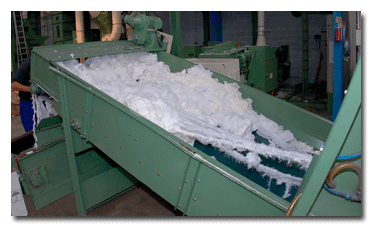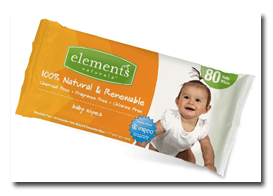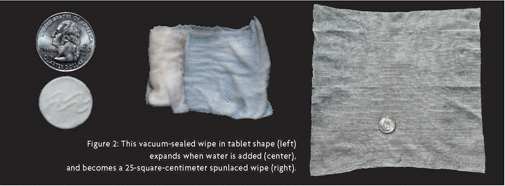H
istorically, the development and success of the nonwovens industry were largely based on
disposable products. When nonwovens appeared on the markets, they were mostly produced to be
disposable. Still today, nonwovens for medical and hygiene products are mainly produced to be
disposable. However, in the last few years, environmental responsibility, sustainability and
reduced raw material consumption have become key concepts in cutting-edge nonwovens production. And
one issue might be the major challenge of tomorrow: flushability.
This past September, the 48th Dornbirn Man-made Fibers Congress took place in Dornbirn,
Austria. More and more, nonwovens are playing an important role at this congress, too. This is not
a surprise, as nonwovens are produced mainly using man-made fibers.
The man-made fibers industry has learned its lesson. Speakers at Dornbirn were known for
years to wholly neglect any environmental impact, and not only from the fiber industry. This time,
many papers challenged the natural fibers industry in different areas: production, finishing and
environmental impact. The conclusion of the event was astonishing. The presentations revealed an
overall new approach by the synthetic and artificial fibers industry that was unimaginable a few
years ago: Sustainability, environmental consciousness and climate change were the topics. What
does this mean for nonwovens?

Figure 1: Recycled fiber, shown here being processed on a Laroche machine, will play an
ever-more-important role in nonwovens production.
Water Consumption
Whatever technology is applied to form a web, new requirements are in focus including reduced
water, energy and raw material consumption. Recycling of fibers and textile waste will play a more
important role, too
(See Figure 1). With the apparent climate change, whether generated by mankind or not,
water consumption will be one of the big issues in the future, if not the most important one. Water
might become one of the most desired and expensive raw materials.
Traditional disposables, like hygiene and medical products, are in real trouble because of
tighter environmental laws. There soon will be no more landfills to handle used disposables. The
industry is challenged: Every production stage, from fiber to finishing, must reinvest heavily in
new production technologies. Therefore, the big disposable products labels are looking more and
more for biodegradable products. “Responsibility has to become the key issue of economic, social
and environmental activities,” said one speaker at the Dornbirn congress.
Tailor-made Fibers
Basically, there is no true secret in nonwovens production today. Whether products may be
dry- or wetlaid, spunbonded, spunlaced or needlepunched, future sustainable achievements can only
be concluded if environmental issues are taken into consideration. Technologies that use no water
for the web-bonding process have some advantages – but only at first sight.
By applying the right forming and bonding techniques, water consumption is drastically
reduced. Also, modern wetlaid or spunlaced production lines are recycling almost all of the water
consumed in a closed loop. Furthermore, thanks to ongoing machine improvements, weights are
possible down to 10 grams per square meter, which means reduced fiber consumption. However,
needlepunching technology, with its latest machinery developments, still has a slight advantage
over other bonding technologies, thanks to its versatility.
Biodegradable Fibers
The fiber-producing industry is heavily active in research for new fiber types that are
derived from renewable sources. New and advanced fiber types like polylactic acid (PLA), derived
from corn or other vegetable starches, and viscose, derived from wood, take the environmental
aspects very much into consideration and enable promising new products for changing customer
attitudes. Yarn producers are in the forefront to bring new bio-based products to market. If these
products are competitive, the nonwovens industry will follow suit.
Biopolymers are interesting because of increasing oil prices and limited availability of
fossil raw materials. The materials are even compostable under specific conditions. However, PLA
production uses less fossil fuel but more land and water than petrochemical-based polymers.
Agriculture is needed in the first place for food, but PLA production is said to require less than
0.04 percent of global corn supplies.
Lenzing AG, Austria, produces the three main generic man-made cellulosic fiber types:
viscose, modal and lyocell. Its Tencel® lyocell fibers are made from wood grown in managed forests.
Cellulose from wood pulp is dissolved in an organic solvent, and the resultant viscous solution is
extruded into an aqueous spin bath. During the process, the cellulose is not changed chemically.
The spinning process is a closed-loop solvent spinning system in which the solvent is recovered for
reuse. As a result, there is virtually no release into the environment from the process. The result
is a pure cellulose fiber with good moisture handling, thermal properties, microbiological effects
and biocompatibility. It is biodegradable for safe disposability.

Elements Naturals™ 100% Natural and Renewable baby wipes are made with Ingeo™ bio-based
polylactic acid fibers, which are produced using 68-percent fewer fossil fuel resources than
petroleum-based fibers and also contain no chemical additives or surface treatments.
Medical And Hygiene Applications
According to Lenzing, Tencel is better placed than competing fibers for medical applications
due to its combination of properties. The hydrophilic fiber has a smooth surface with a rounded
cross-section, giving fabrics that are smooth, have low friction and feel good. It is highly
absorbent and provides excellent moisture management.
Tencel C is a new product that is being assessed for applications including apparel, hygiene
and active sportswear. It is produced by treating Tencel with chitosan during manufacturing.
Chitosan is deacetylated chitin – the main structural polymer in the shells of many shellfish and
other invertebrates. Chitosan has been shown to influence wound healing and in the right
presentation performs well as a hemostat. It is also in use for antibacterial products. Clinical
tests have shown the new fiber gives a positive effect on wound healing, morphology and cell
proliferation at the wound margin. One of the main observations with regard to chronic wounds is
that they show a significantly reduced rate of cell proliferation. Lenzing claims Tencel C has
better performances compared to other dressing materials tested.

Flushability
“Carbon footprint” and “life cycle analysis” are key terms for new cutting-edge products.
What can happen if a product is not designed from cradle to cradle, and if these points are not
taken into consideration, is drastically demonstrated with modern wipes.
Wipes are among the most successful nonwoven products. With the improvement of spunlaced
machinery, wipes started their road to success virtually around the world. In stores everywhere,
there are endless shelves full of wet wipes, refreshing towels and other similar products. Problems
occurred right after their success and present the industry with a big challenge – flushability.
Refreshing towels or wet wipes often are flushed down the toilet. After flushing, they do not
entirely disintegrate and can clog the whole wastewater system down to the wastewater plant. The
result is obvious. Thanks to the requisite product performance, the wipes don’t dissolve; the
system collapses, and it takes a lot of money and efforts to clean it up.
The latest development of a modern wipe is a vacuum-sealed product in tablet shape the size
of a US quarter. When water is added, the product starts growing. The final product is a
25-square-centimeter spunlaced wipe, which certainly will be flushed down the toilet, and the
problems start again
(See Figure 2).
Modern wipes must have not only functional requirements, but also great flushability to
disintegrate as quickly as possible. This is probably the quadrature of the circle and just another
challenge for the ever-so-promising nonwovens industry.
November/December 2009




